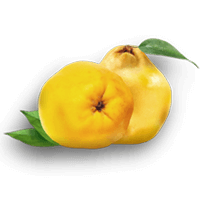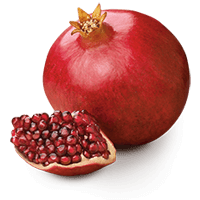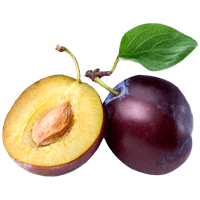Persimmon: Nutrition, Glycemic Index, Acidity, & More

Summary
Persimmons are nutrient-dense fruits, containing 64% water and 36% nutrients, mainly carbohydrates. They contain 33.5g of carbohydrates, 20% of which is dietary fiber, and the rest are simple sugars, mainly glucose and fructose.
Persimmons are rich in vitamin C; 100g covers the recommended daily value of vitamin C by 73%. Persimmons are also rich in vitamin A and its precursors, iron, and phytochemicals and low in oxalates and sodium.
Table of contents
Introduction
People have cultivated persimmons for thousands of years. They originated in China and have since spread worldwide; however, they are still among the most popular fruits in Eastern Asian countries.
Classification & Varieties
Persimmons belong to the genus Diospyros and the Ebenaceae family. Persimmons have many varieties. Today, the most popular ones are considered to be the Japanese or Asian persimmons, scientifically named Diospyros kaki, particularly the Hachiya and Fuyu varieties.
These orange fruits grow in colder seasons, maturing in late fall, October or November. The taste of persimmons is described as sweet, often resembling honey. It is not commonly known that, much like tomatoes, persimmons are botanically berries.
Commercially, persimmons are divided into two groups: astringent and non-astringent. The main difference between the two lies in the levels of a phytochemical called tannin. Astringent varieties contain high levels of tannins and can taste bitter when used not completely ripe. Non-astringent persimmons, on the other hand, containing lower levels of tannins, can be enjoyed even before fully ripening.
Hachiya is the most common astringent persimmon variety, and non-astringent persimmons are represented by Fuyu.
Nutrition
In this article, we’ll look into the nutrition of 100g of the common astringent persimmon, also called Diospyros virginiana, eastern or American persimmon. The average weight of one fruit (without refuse) is nearly 25g.
Persimmon consists of 64% water and 36% nutrients, mainly carbohydrates.
Macronutrients chart
Calories
A hundred grams of persimmon provides 127 calories. However, the average serving size of this fruit is one average persimmon that provides 32 calories.
Asian or Japanese persimmons have higher water and lower calorie contents, containing only 18 calories per fruit (1).
Persimmon is considered to be a low-calorie food.
What Do 127 Calories or 100 Grams of Persimmon Look Like?
Our team measured what 100 grams of persimmon looks like to help you visualize its weight and calories.
The image below shows that approximately two pieces of persimmon make up 100 grams, equating to 127 calories. This implies that a medium-sized persimmon weighing around 160 grams corresponds to roughly 200 calories. It's important to note that calorie values may vary based on the fruit's size and ripeness.
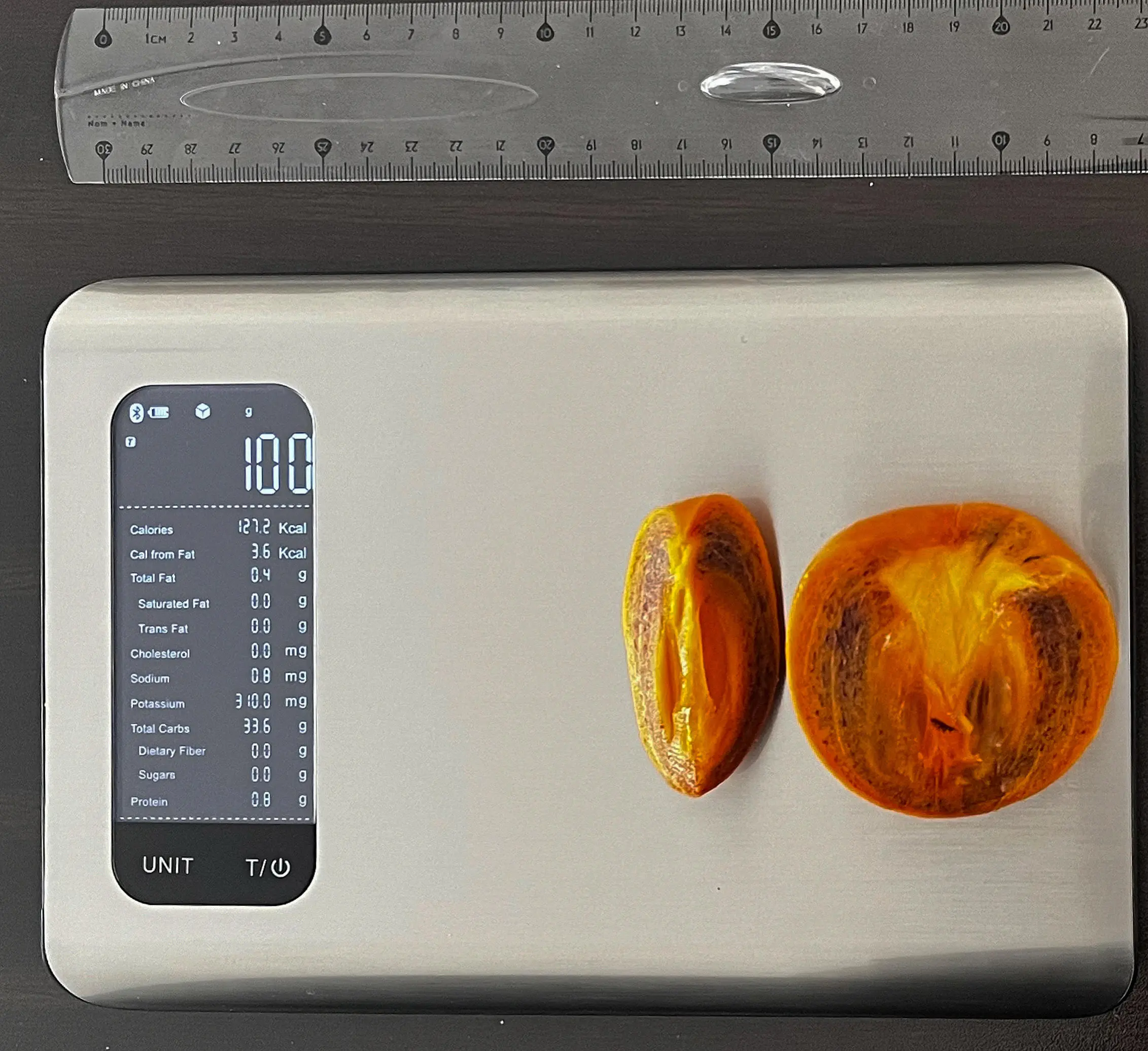
Carbohydrates
A 100g of persimmons contains 33.5g of total carbohydrates, while one average persimmon contains 9g of total carbohydrates, dietary fiber making up 20%.
Japanese persimmons contain 18.6g of total carbohydrates: 3.6g of dietary fiber and simple sugars, mainly glucose (5.44g) and fructose (5.56g), with a lower sucrose content (1).
Dietary Fiber
According to several studies, persimmon and its byproducts are rich in both soluble and insoluble dietary fiber, with a higher insoluble fiber content (2, 3).
Protein
Persimmons are low in proteins, containing 0.8g per 100g serving of the fruit.
Fat
Persimmons are even lower in fats than they are in proteins. A 100g of persimmon contains 0.4g of fat.
Persimmons are naturally absent in cholesterol and trans fats.
Vitamins
The common astringent or American persimmon is abundant in vitamin C: 66mg per 100g serving, covering the recommended daily value of vitamin C by 73%.
Vitamin C is a physiological antioxidant, also required for the biosynthesis of collagen and several neurotransmitters (4).
Persimmons are also a good source of vitamin A RAE, containing 81 mcg. Persimmons are also rich in vitamin A precursors beta-carotene (251 mcg) and beta-cryptoxanthin (1450 mcg) (1).
Vitamin coverage chart
Minerals
American persimmons are significantly high in iron, containing 2.5mg per 100g serving and covering the recommended daily value of iron by 31% for men and 14% for women.
Iron is an essential component of hemoglobin, a protein that transports oxygen from the lungs to the tissues and cells. Not only is the American persimmon rich in iron, but it is also rich in vitamin C, improving the absorption of plant-based iron (4, 5).
American persimmons also contain some levels of potassium, calcium, and phosphorus.
Japanese persimmons contain most minerals in negligible amounts.
Persimmons are naturally very low in sodium.
Mineral coverage chart
Oxalates
Oxalates or oxalic acids are food compounds linked to a type of kidney stones called calcium oxalate stones. They are mainly harmless; however, some people are prone to developing calcium oxalate stones and should avoid food rich in those compounds.
Persimmon contains 7mg of oxalates per 100g, making it a low-oxalate food.
Phytochemicals
Phytochemicals or phytonutrients are biologically active compounds with antioxidant properties that decrease the risk of developing chronic diseases and cancer.
Tannins are one of the most important phytochemicals found in persimmons. Tannins or tannoids belong to the major phytochemical called polyphenols. They are studied for their antioxidant, antibacterial, antiviral, anti-inflammatory, and anti-diarrheal activity (7).
As previously mentioned, astringent varieties are high in tannins, whereas non-astringent varieties are low.
According to research, tannic acid reduces small intestinal secretions and slows down bowel movements; thus, avoiding persimmons in higher quantities is suggested for people with chronic constipation (8).
Persimmons also contain many phytochemicals that act as antioxidants: polyphenols, carotenoids, and tocopherols. Some prevalent components in persimmon leaves and fruits are flavonoid oligomers, phenolic acids, and catechin (9).
Glycemic Index
A glycemic index is a tool that assesses the potential of carb-containing food to raise blood sugar levels.
Persimmons have a glycemic index of 61, making these fruits fall under the category of low glycemic index foods (10).
Persimmon syrup has been researched to benefit diabetic patients due to its positive effects on blood glucose levels (11). You can find detailed information about this topic on our "Persimmon and Diabetes - Is It Good For Diabetics" page.
Glycemic Load
Food's glycemic load calculates how much an average serving size will raise one’s blood glucose levels.
The glycemic load of persimmon is calculated to be 5, making it a low-glycemic-load food.
Insulin Index
The insulin index of foods shows how much the blood insulin level will rise in the first two hours after food consumption.
The insulin index of persimmon is 47. For comparison, the insulin index of glucose is 100.
You can visit our "Glycemic Index vs. Insulin Index" page to learn the differences between glycemic and insulin indices.
Acidity
Persimmon has a pH value of 4.42 to 4.70, making it an acidic fruit (12).
Nevertheless, persimmon is classified as a low-acid fruit, presenting titratable acidity in malic acid around 0.16% to 0.23% (13).
Based on the potential renal acid load (PRAL), the acidity of persimmons has been calculated to be -5.5, making it alkaline-forming. PRAL shows the base or acid production capacity of the food inside the organism.
Weight Loss & Diets
One research showed that in high-fat diet-fed animals, persimmon supplementation helped significantly reduce the rise in plasma lipids, including total cholesterol, triglycerides, and low-density lipoprotein or “bad” cholesterol levels. This is said to be due to persimmons’ ability to regulate bile acid synthesis (14).
Another study has come to a similar conclusion that persimmons can have anti-obesity qualities by regulating lipid metabolism. The aqueous extract of persimmon fruit inhibits the synthesis of fat and lipids and regulates intracellular mechanisms related to lipids (15).
However, due to the high sugar content of persimmons, these fruits have to be used in moderation during a weight loss diet.
Here, we will talk about how persimmon fits into some specific diets.
| Keto | Keto diet guidelines recommend that the net intake of carbohydrates be 15 to 30g per day. One average persimmon contains 9g of carbohydrates; therefore, this fruit isn’t the best fit for a keto diet. However, some varieties of persimmons contain fewer carbohydrates. For example, Japanese persimmons contain only 4,6g of carbs per fruit. |
| DASH | The DASH diet is rich in fruits. Persimmons are very low in sodium but rich in calcium and potassium. This makes persimmon a good option for this diet. Some research has also demonstrated the hypotensive effects of persimmons (16). |
| Atkins | In the first phase of the Atkins diet, you’re encouraged to eat 12 to 15g of carbs a day, only from vegetables, so you can not have persimmons during this phase. Phase 2 allows room for some low-carb fruits; however, persimmons are not quite advisable. Starting from Phase 3, you can use persimmons in moderate amounts (17). |
| Mediterranean | Persimmons have been cultivated in the Mediterranean area for over a century (18). It fits this diet. |
| Paleo | Persimmons have been used as food by people for thousands of years, and fruit being one of the most important aspects of the paleo diet makes persimmons an excellent choice for this diet. |
| Vegan/ Vegetarian/ Pescetarian | As fruits, persimmons are suitable for vegan, vegetarian, and pescetarian diets. |
| Dukan | Eating carbs is not advisable during the Attack and Cruise phases. You can add persimmons to your diet during the Consolidation phase, however, only in moderation. |
| Intermittent Fasting | Like most other foods, persimmons are fine to use during the eating periods but have to be refrained from during fasting. |
| Low Fat & Low Calorie | Japanese persimmons are preferred during a low-calorie diet, unlike common persimmons. All persimmons are very low in fat and fit the diet. |
| Low Carb | On a low-carb diet, the variety of the fruit is worth paying attention to. Depending on the variety, one persimmon can contain 4 to 9g of carbs. |
| Anti Inflammatory | Persimmons are a great source of vitamin C and other phytochemical antioxidants. Therefore, these fruits can help ease inflammatory processes (19). |
| BRAT | Persimmons can be used to treat diarrhea caused by a weak digestive system (20). |
References
- https://fdc.nal.usda.gov/fdc-app.html#/food-details/169941/nutrients
- https://www.ncbi.nlm.nih.gov/pmc/articles/PMC8615262/
- https://iopscience.iop.org/article/10.1088/1755-1315/954/1/012031/pdf
- https://ods.od.nih.gov/factsheets/VitaminC-HealthProfessional/
- https://ods.od.nih.gov/factsheets/Iron-HealthProfessional/
- https://www.researchgate.net/publication/259133562
- https://www.ncbi.nlm.nih.gov/pmc/articles/PMC8784788/
- https://www.ncbi.nlm.nih.gov/pmc/articles/PMC4291444/
- https://www.ncbi.nlm.nih.gov/pmc/articles/PMC4817420/
- https://academic.oup.com/ajcn/article/83/5/1161/4649595
- https://www.researchgate.net/publication/264027834
- https://www.clemson.edu/extension/food/food2market/documents/ph_of_common_foods.pdf
- https://www.scielo.br/scielo.php?script=sci_arttext&pid=S0001-37652017000301205#B23
- https://www.researchgate.net/publication/6656022
- https://www.liebertpub.com/doi/10.1089/jmf.2019.4557
- https://pubmed.ncbi.nlm.nih.gov/527152/
- https://www.atkins.com/how-it-works/library/articles/summer-vegetables-fruits-for-a-low-carb-diet
- https://hort.purdue.edu/newcrop/proceedings1996/V3-416.html#Persimmon
- https://journals.plos.org/plosone/article?id=10.1371/journal.pone.0183489
- http://www.china.org.cn/health/2008-09/09/content_16416466.htm#
Important nutritional characteristics for Persimmon

|
Glycemic index ⓘ
Source:
Check out our Glycemic index chart page for the full list.
|
61 (medium) |
| Glycemic load | 5 (low) |
| Insulin index ⓘ Falls in a large range https://synapse.koreamed.org/articles/1043926 | 47 |
| Calories ⓘ Calories per 100-gram serving | 127 |
| Net Carbs ⓘ Net Carbs = Total Carbohydrates – Fiber – Sugar Alcohols | 33.5 grams |
| Serving Size ⓘ Serving sizes are taken from FDA's Reference Amounts Customarily Consumed (RACCs) | 1 fruit without refuse (25 grams) |
| Acidity (Based on PRAL) ⓘ PRAL (Potential renal acid load) is calculated using a formula. On the PRAL scale the higher the positive value, the more is the acidifying effect on the body. The lower the negative value, the higher the alkalinity of the food. 0 is neutral. | -5.5 (alkaline) |
| Oxalates ⓘ https://www.researchgate.net/publication/259133562 | 7mg |
Persimmon calories (kcal)
| Serving Size | Calories | Weight |
|---|---|---|
| Calories in 100 grams | 127 | |
| Calories in 1 fruit without refuse | 32 | 25 g |
Persimmon Glycemic index (GI)
Persimmon Glycemic load (GL)
Mineral chart - relative view
Vitamin chart - relative view
Protein quality breakdown
All nutrients for Persimmon per 100g
| Nutrient | Value | DV% | In TOP % of foods | Comparison |
| Calories | 127kcal | 6% | 66% |
2.7 times more than Orange
|
| Protein | 0.8g | 2% | 87% |
3.5 times less than Broccoli
|
| Fats | 0.4g | 1% | 82% |
83.3 times less than Cheddar Cheese
|
| Vitamin C | 66mg | 73% | 11% |
1.2 times more than Lemon
|
| Net carbs | 33.5g | N/A | 24% |
1.6 times less than Chocolate
|
| Carbs | 33.5g | 11% | 25% |
1.2 times more than Rice
|
| Cholesterol | 0mg | 0% | 100% |
N/A
|
| Iron | 2.5mg | 31% | 28% |
Equal to Beef broiled
|
| Calcium | 27mg | 3% | 46% |
4.6 times less than Milk
|
| Potassium | 310mg | 9% | 35% |
2.1 times more than Cucumber
|
| Phosphorus | 26mg | 4% | 86% |
7 times less than Chicken meat
|
| Sodium | 1mg | 0% | 98% |
490 times less than White Bread
|
| Vitamin B12 | 0µg | 0% | 100% |
N/A
|
| Trans Fat | 0g | N/A | 100% |
N/A
|
| Tryptophan | 0.01mg | 0% | 94% |
21.8 times less than Chicken meat
|
| Threonine | 0.04mg | 0% | 94% |
17.6 times less than Beef broiled
|
| Isoleucine | 0.04mg | 0% | 95% |
26.1 times less than Salmon raw
|
| Leucine | 0.06mg | 0% | 95% |
41.9 times less than Tuna Bluefin
|
| Lysine | 0.05mg | 0% | 95% |
10 times less than Tofu
|
| Methionine | 0.01mg | 0% | 97% |
13.7 times less than Quinoa
|
| Phenylalanine | 0.04mg | 0% | 95% |
18.6 times less than Egg
|
| Valine | 0.04mg | 0% | 95% |
48.3 times less than Soybean raw
|
| Histidine | 0.02mg | 0% | 96% |
46.8 times less than Turkey meat
|
Check out similar food or compare with current
NUTRITION FACTS LABEL
Serving Size ______________
Health checks
Persimmon nutrition infographic
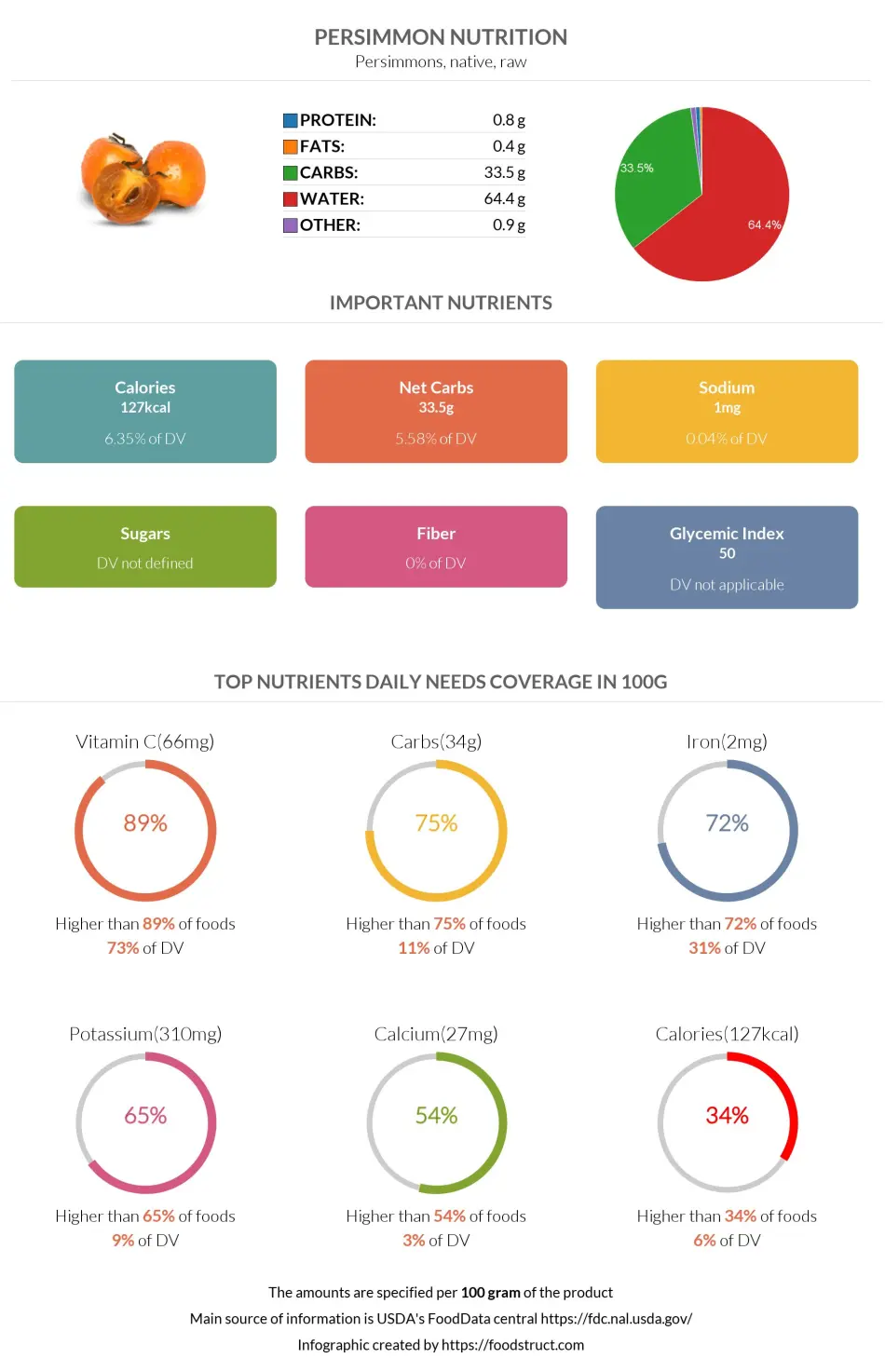
References
All the values for which the sources are not specified explicitly are taken from FDA’s Food Central. The exact link to the food presented on this page can be found below.

